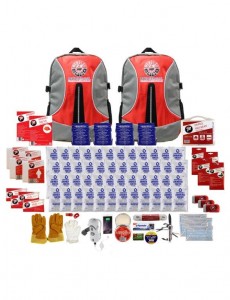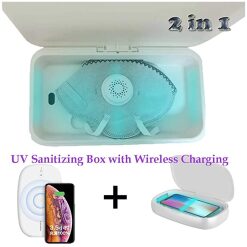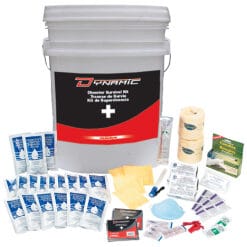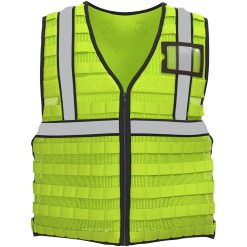Emergency Preparedness
Do You Have a Survival Plan?
Do You Have a Survival Plan In Place?
You’ve heard it in the media, you’ve read about it on the internet: “Massive storm wreaks havoc on city”, “Power outage leaves thousands without power”, “Municipal water unsafe to drink”, etc. The notion of it will never happen to me leads you to worry about other life events and happenings. All of a sudden one day your power goes out; the radio announcer talks about a massive storm heading your way; your municipal health department issues a warning about the drinking water; and you think to yourself “Now what?”
The purpose of having an emergency survival plan is to ensure that you and your family are ready to survive should you need to. It’s a temporary plan that allows you to survive a minimum of 72 hours while you reassess the major event that has just occurred and establish a more permanent plan.
Consider this. Do you have enough food and water to survive 72 hours or longer? Remember, if you lose power your electric stove won’t work, and your microwave is not operational. Your gas stove will possibly work but the vent above it that normally vents the dangerous combustion fumes won’t work. Can the food you currently have in your house be prepared without the use of any electrical appliance?
What if the water supply to your home stops? If you’re on a well system and the power is out so is your supply of water. What if your municipality issues a contaminated water alert and deems your water source unsafe to drink?
All this talk about doom and gloom isn’t fun but in today’s society it’s a harsh reality. You can plan ahead now and be prepared by making sure you have some basic necessities at hand.
Rapid Survival has put together a list of things you should consider having ready as part of your survival plan. This survival plan list is by no means an exhaustive list and we welcome suggestions in the comments section of this post.
Communication
- A hand crank powered radio (AM/FM) will allow you to listen to broadcasts and receive information about what is happening in your area.
- Family band walkie talkies, provide close distance communication if you or a family member need to venture away from your location of safety.
- A hand crank cell phone charger can keep your cellphone phone charged in the event of a power outage. At first during a major emergency the cellular system will most likely be jammed, but given a day or two it should be accessible again.
Clothing
- Is it summer or winter? Keep an assortment of clothing in your survival kit and rotate it for the appropriate season.
- Keep a good pair of winter boots for each member of your family with your kit during the winter months, and a good hiking shoe in summer months.
- If you’re away from your home when disaster strikes:
- Have a rain coat or poncho available.
- Have a reflective vest handy, this ensures people can see you (assuming you want them to).
- Add some spare socks. Your mother always told you to pack extra socks and as much as you don’t want to admit it, she was right! There isn’t anything worse than cold and wet feet.
Protection From The Elements
- Your furnace won’t work if the power is out. How are you going to stay warm?
- Dedicate a room in your home as the warm room. Keep extra blankets in this room and a good supply of candles for light and heat. Don’t forget some matches or a lighter. Always exercise caution when using candles and ensure proper room ventilation.
- If you’re away from your home when disaster strikes:
- Have a sleeping bag handy. It doesn’t have to be big and bulky; an emergency blanket can fold up into a pocket size pouch.
- Have a way to make a temporary shelter
- A simple small tarp could mean the difference between a rain soaked evening and a comfortable dry evening.
Food and Water
- How will you prepare food? There are many options that allow you to store food rations for anywhere between 5 years and 25 years. These rations usually require little to no work to prepare. Most are as simple as adding water.
- Where will you get water? Keeping a supply of water is as simple as buying an extra case or two of bottled water when you go grocery shopping.
- Another location that is almost always overlooked is your hot water tank. It’s a giant tank in most households that holds a significant amount of water. Tap into any resource you can, just make sure it’s safe to drink first. Adding water purification tablets or a filter to your 72 hour survival kit will ensure you have clean, safe drinking water.
Identification
Make copies of important documents such as copies of birth and marriage certificates, passports, licences, wills, land deeds and insurance. Have photos of family members on hand in case a lost person’s record needs to be created. Keep them in a safe place, both inside and outside your home. You might want to put them in a safety deposit box or give them to friends and family who live out of town.
Plan for Pets
In case of an evacuation, remember that pets are not allowed in some public shelters or hotels. In case of an evacuation, prepare to take your pets with you to the home of a relative or friend, or take steps to identify pet-friendly hotels or pet boarding facilities in your area and further away from home.
Get an Emergency Kit
Rapid Survival 72 Hour Survival Kit Essential or Deluxe edition is an important part of any household emergency preparedness plan. The Canadian Government suggests that all households have enough supplies to survive a minimum of 72 hours during an emergency disaster situation.
With the prevalence of natural disasters and emergencies, an Emergency Survival Kit is crucial for your emergency preparedness plan. The Rapid Survival 72 hour survival kit is designed for all emergencies—from major storms, power outages, floods, earthquakes, or any other disasters— our 72 Hour essential or deluxe survival kit has you covered.
Be prepared to be self-sufficient for at least 72 hours. The key is to make sure your survival plan kit is organized and easy to find. Would you be able to find your flashlight in the dark? Make sure your kit is easy to carry and everyone in the household knows where it is. Keep it in a backpack, duffle bag or suitcase with wheels, in an easy-to-reach, accessible place, such as your front-hall closet. If you have many people in your household, your emergency kit could get heavy. It’s a good idea to separate some of these supplies in backpacks. That way, your kit will be more portable and each person can personalize his or her own grab-and-go emergency kit. A disaster survival kit from Rapid Survival is the perfect solution! Buy yours today and get yourself and your family prepared!
Let’s start the discussion on being prepared for the unexpected. Please post your ideas below in the comments section. Remember it can happen to you! we hope it doesn’t but if it does we want you to be prepared.
Contagion Control
72 Hour Survival Kits






